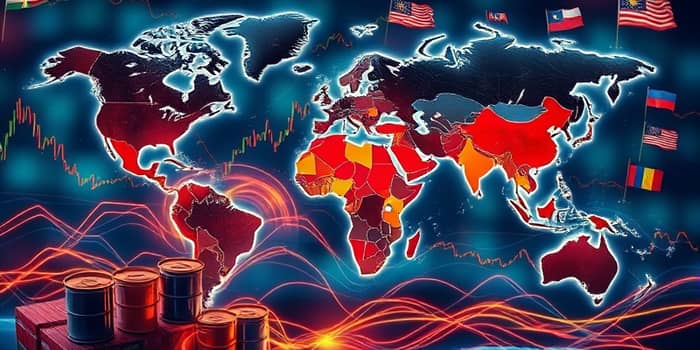
The interplay between international relations and financial markets has grown increasingly complex. As investors and policymakers navigate this fraught landscape, understanding how conflicts and diplomatic maneuvers affect asset valuations is more critical than ever. This article unpacks the quantifiable effects of geopolitical shocks, explores economic statecraft trends, and offers practical guidance for building resilient portfolios in turbulent times.
Geopolitical risks—from armed conflicts to sanctions—have surged to multi-year highs, leaving an indelible mark on global asset prices. In the aftermath of major events, equity markets can slump by an average of 1% in advanced economies and up to 2.5% in emerging markets.
Military conflicts provoke even sharper reactions. Stocks in emerging markets have plunged by as much as 5% in a single month following direct hostilities, while sovereign debt risk premiums can spike dramatically.
These sudden swings underscore the importance of vigilant risk management practices that incorporate geopolitical indicators alongside traditional financial metrics.
Investors often struggle to price geopolitical events due to their rarity and unpredictability. Nevertheless, historical data offers valuable insights into typical market responses:
Conflicts such as the Russia–Ukraine war and the Israel–Hamas crisis have had lasting consequences for commodity markets, pushing energy and food prices higher and fueling inflationary pressures worldwide.
By tracking these metrics, analysts can calibrate stress tests and scenario models, enabling more robust capital allocation during periods of uncertainty.
Geopolitics now permeates trade policy in unprecedented ways. Economic statecraft—where nations deploy tariffs, sanctions, and export controls to achieve strategic goals—is reshaping global supply chains.
This shift away from pure commercial logic toward weaponizing economic interdependence demands that corporations rethink sourcing strategies and diversify production footprints.
Each major region grapples with distinct pressures. The European Union confronts high energy costs, possible new US tariffs, and limited fiscal space, leading to a modest growth forecast of 0.8%–1.6% for 2025.
In the United States, political shifts may herald increased protectionism and a recommitment to domestic manufacturing. Such moves can stoke volatility, affecting everything from bond yields to technology stocks.
The Asia-Pacific region remains a long-term growth engine, yet it faces the brunt of US–China tensions. Trade realignments and competition for strategic resources are forcing regional powers to seek new partnerships and logistical routes.
Not all asset classes respond equally to geopolitical developments. Energy, food, and commodity markets are highly sensitive to supply disruptions; by contrast, safe-haven assets like government bonds and gold often attract capital inflows during crises.
Real estate exposed to instability—for example in Hong Kong—can suffer valuation declines, while technology and biotech are emerging frontiers for national security considerations, leading to regulatory scrutiny and potential localization mandates.
To navigate these treacherous waters, investors should adopt a multi-pronged approach:
By blending traditional financial analysis with geopolitical intelligence, investors can uncover opportunities even amid crisis.
While the prospect of escalating tensions may seem daunting, history shows that markets adapt. Periods of upheaval often seed innovation: alternative energy projects gain urgency when oil supply is threatened, digital supply chain solutions flourish under trade restrictions, and regional trade agreements accelerate in response to global fragmentation.
Investors who cultivate adaptive portfolio frameworks and remain attentive to geopolitical trends can not only protect capital but also capture outsized returns when stability returns.
Ultimately, the intersection of geopolitics and markets challenges us to think beyond quarterly earnings and GDP growth figures. It compels a holistic view—one that appreciates the interplay between national ambitions and economic incentives.
By marrying rigorous data analysis with strategic foresight, financial professionals can steer through uncertainty and harness the transformative power of global events.
References













